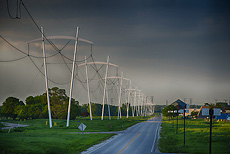Brainstorming a more sustainable laboratory
 |
Fermilab's Sustainability Committee was formed to brainstorm new ways for the laboratory to practice environmentalism and energy efficiency. One method already in use is the purchase of renewable energy certificates with the lab's electricity, thereby investing in sustainable forms of energy. Photo: Reidar Hahn
|
Why is it important for a facility like Fermilab to think about and implement sustainable practices? Because if you don't, says Eric Mieland, you're behind the curve.
Sustainability and energy efficiency have been watchwords at Fermilab for decades. Even the laboratory's most powerful accelerators were designed and operated with an eye toward keeping energy consumption low. In 2010, the Department of Energy renewed its focus on sustainable practices, setting ambitious long-term goals for its laboratories.
That's one reason Mieland, an environmental officer with Fermilab's ESH&Q Section, gave for the formation of a sustainability committee, the first in the laboratory's history. Mieland and Rod Walton, environmental officer for FESS, met with then-Chief Operating Officer Bruce Chrisman to form a committee focused on coming up with new ways to be more energy-efficient and environmentally friendly.
"The goal was to form a group with representatives from each division and section, including key positions such as the lab's energy, fleet and procurement managers," said Mieland. "We would come up with ideas that could be taken back to that division or section and put into practice."
Since early 2011, a group of roughly a dozen people from all corners of the laboratory has met on a regular basis to talk about a wide range of issues. They've tackled everything from improving the efficiency of the accelerators to encouraging employees to carpool.
"It's the only committee charged with going beyond what we have to do," Walton said. "Our charter letter charges us to advocate for sustainability measures that go beyond what's required."
The requirements are fairly ambitious in themselves. DOE has set agency goals for the reduction of greenhouse gases by 2020, and since most of the laboratory's emissions come from purchased electricity, the lab is looking for creative ways to bring those numbers down. One idea already in practice is the purchase of renewable energy certificates, Mieland said, which allows the lab to fund green energy in an amount equal to the power it uses.
The computing centers use more power than anything else at the lab except the accelerators, Mieland said, and work is under way at the Grid Computing Center to increase efficiency there. The lab's fleet of vehicles runs largely on E85 and biodiesel, both renewable fuels.
But it's not just about large-scale efficiencies. Walton said much of the committee's discussion has focused on encouraging employees to cut back on their own greenhouse gas emissions. With employees driving an average of 30 miles round trip each day, getting to work pumps nearly 5,000 tons of carbon dioxide into the atmosphere each year.
This summer, the ESH&Q section offered a gas gift card as incentive to sign up with GreenRide Connect, a carpooling database hosted by Argonne National Laboratory. The committee has also brought in representatives from Pace to talk about services they offer, including ridesharing and van pools.
The committee works as an advisory group. And while its charge is vast, its work is important, Mieland said.
"We want more sustainable practices out of necessity, but it's also the right thing to do," he said.
—Andre Salles
|